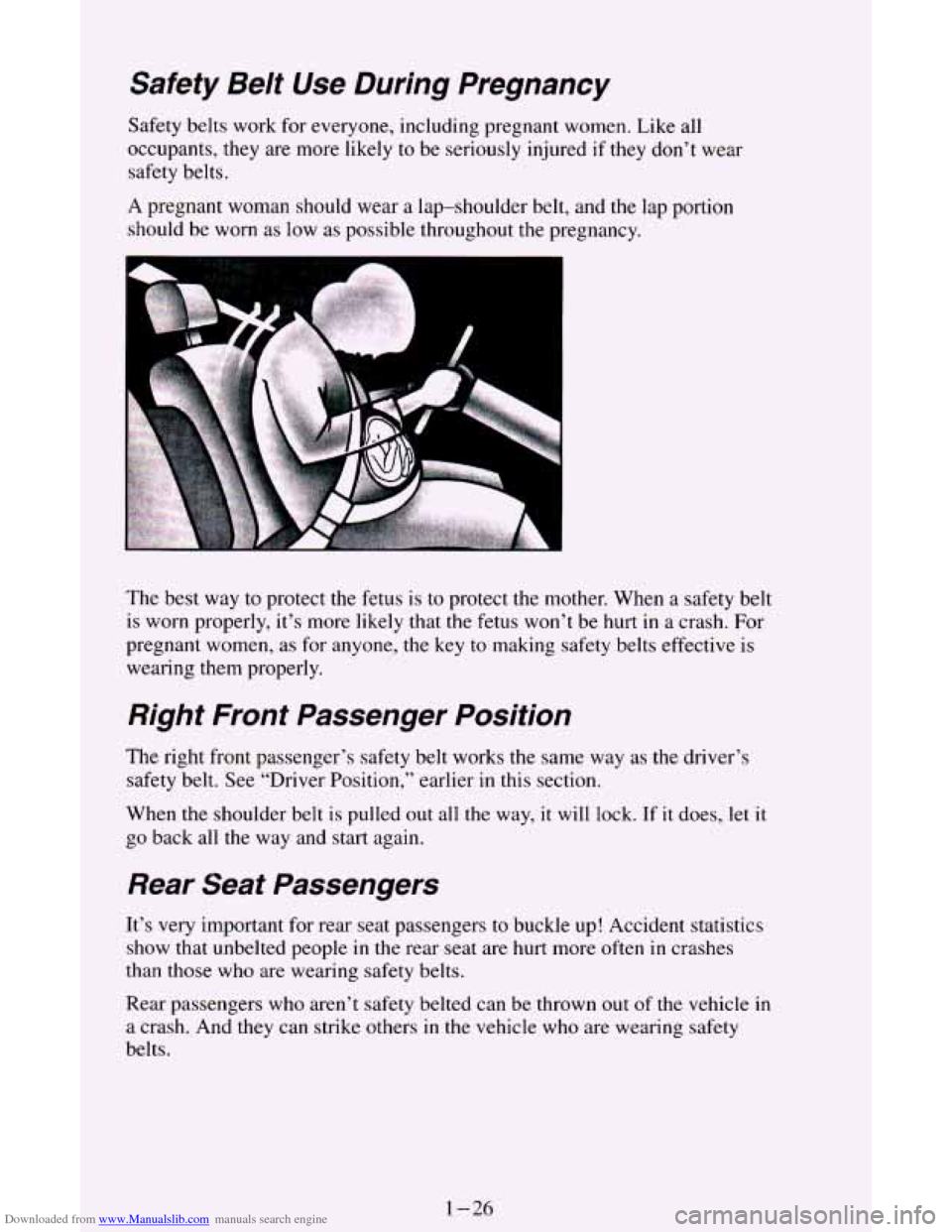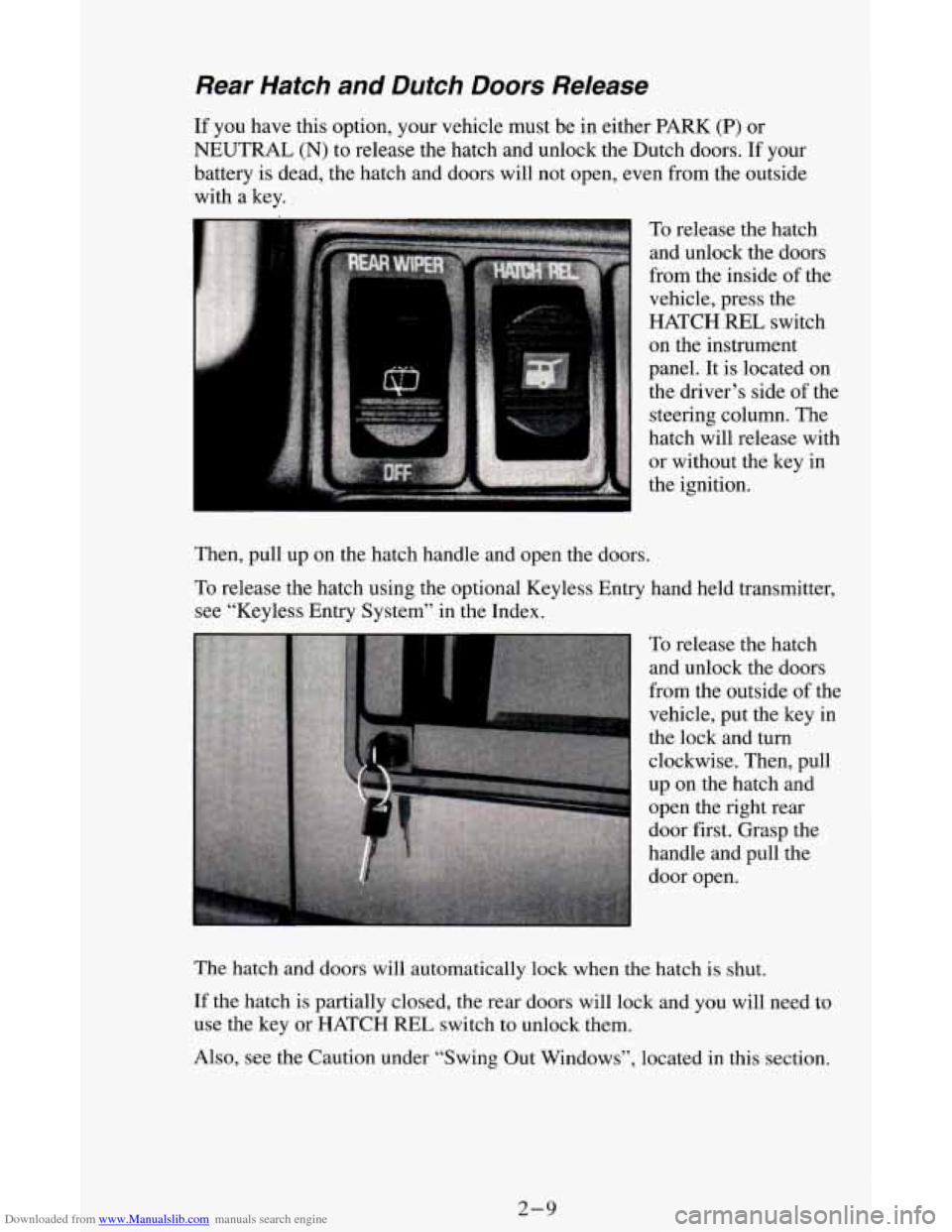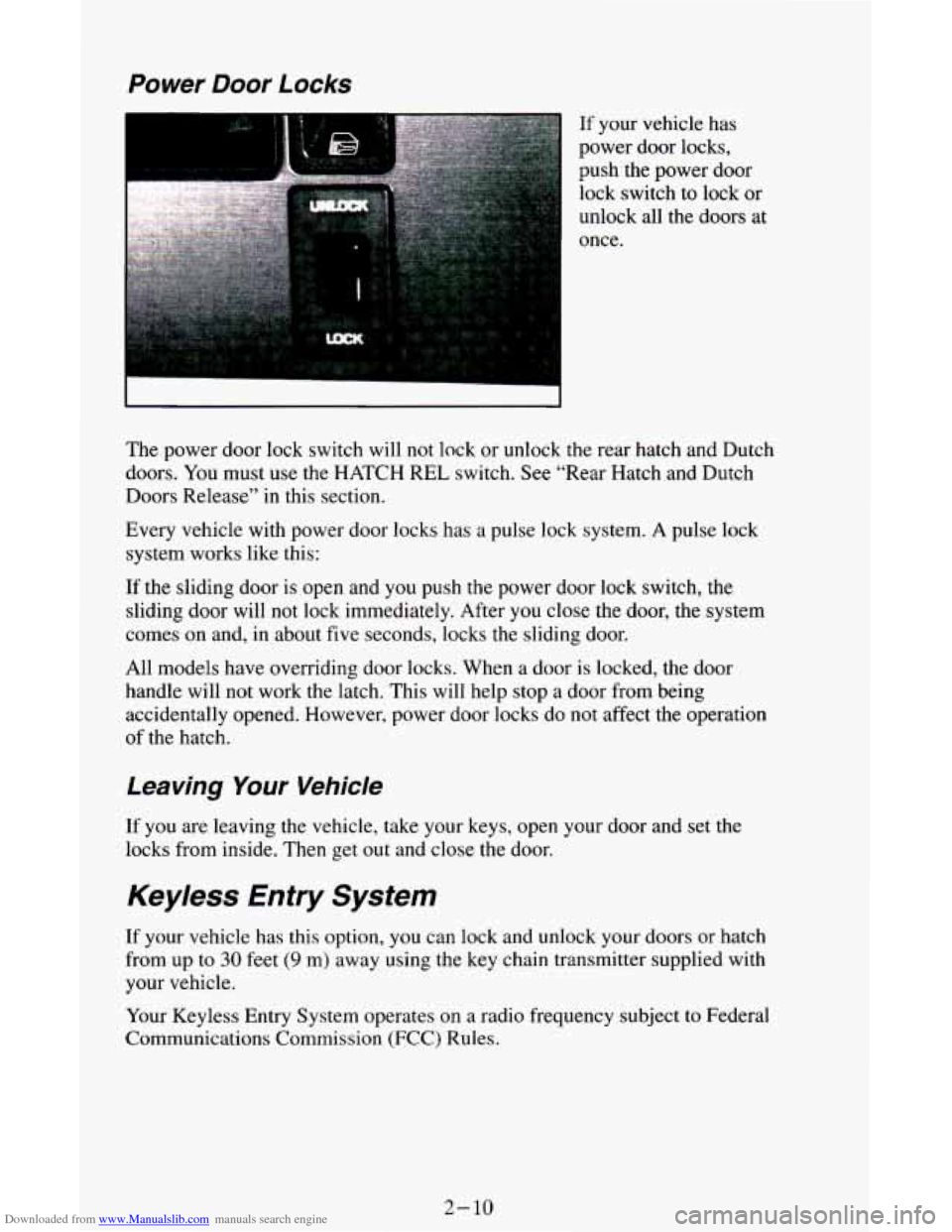Page 19 of 342
Downloaded from www.Manualslib.com manuals search engine Removable Seats (Touring and Non-Touring Bench Seats)
To Remove The Seat
1. Disconnect the quick release latch plates for the lap-shoulder belt from
the buckles
in the roof.
BELTFOR
SEAT REMOVAL I
I I .-+-
1, I=;":
I INTO HOLE 1 I I
2. If you are removing the center seat, remove the right lapshoulder belt.
To do this, press the tip of a key into the release hole of the safety belt
attachment while pulling up
on the safety belt.
1-7
Page 38 of 342

Downloaded from www.Manualslib.com manuals search engine Safety Belt Use During Pregnancy
Safety belts work for everyone, including pregnant women. Like all
occupants, they are more likely to be seriously injured if they don’t wear
safety belts.
A pregnant woman should wear a lap-shoulder belt, and the lap portion
should be worn as low as possible throughout
the pregnancy.
A
The best way to protect the fetus is to protect the mother. When a safety belt
is worn properly, it’s more likely that the fetus won’t be hurt
in a crash. For
pregnant women,
as for anyone, the key to making safety belts effective is
wearing them properly.
Right Front Passenger Position
The right front passenger’s safety belt works the same way as the driver’s
safety belt. See “Driver Position,” earlier in
this section.
When the shoulder belt is pulled out all the way, it will lock. If
it does, let it
go back all
the way and start again.
Rear Seat Passengers
It’s very important for rear seat passengers to buckle up! Accident statistics
show that unbelted people in the rear seat are hurt more often in crashes
than those who are wearing safety belts.
Rear passengers who aren’t safety belted can be thrown out of the vehicle
in
a crash. And they can strike others in the vehicle who are wearing safety
belts.
1-26
Page 55 of 342
Downloaded from www.Manualslib.com manuals search engine Features & Controls
Section
Here you can learn about the many standard and optional features on your
vehicle, and information
on starting, shifting and braking. Also explained
are the instrument panel and
the warning systems that tell you if everything
is working properly
- and what to do if you have a problem.
Keys
2-1
Page 56 of 342
Downloaded from www.Manualslib.com manuals search engine The square-shaped
key is
for the ignitic
only.
3n
The oval-shaped key
is for the doors and
all
other locks.
2-2
Page 57 of 342
Downloaded from www.Manualslib.com manuals search engine
When a new vehicle is delivered, the dealer removes the plugs from the
keys, and gives them
to the first owner.
Each plug has
a code on it that tells the dealer or a qualified locksmith how
to make extra keys. Keep the plugs in a safe place.
If you lose your keys,
you’ll be able to have new ones made easily using these plugs.
I NOTICE:
Your vehicle has a number of new features that can help prevent
theft. But you can have a lot of trouble getting into your vehicle
if you ever lock your keys inside. You may even have to damage
your vehicle to get in.
So be sure you have extra keys.
2-3
Page 62 of 342
Downloaded from www.Manualslib.com manuals search engine There are several ways to lock and unlock your vehicle:
From
the outside: Use
your door key.
From the inside:
To
lock front doors and sliding side door, slide
the lock levers down.
To unlock the front
doors and the sliding
side door from the
inside: Slide the lock
levers up.
Rear doors cannot be manually locked from the inside.
To unlock the rear hatch and Dutch doors from the inside: Push the top of
the
HATCH REL switch.
2-8
Page 63 of 342

Downloaded from www.Manualslib.com manuals search engine Rear Hatch and Dutch Doors Release
If you have this option, your vehicle must be in either PARK (P) or
NEUTRAL
(N) to release the hatch and unlock the Dutch doors. If your
battery is dead, the hatch and doors will not open, even from the outside
with a key.
To release the hatch
and unlock the doors
from the inside of the
vehicle, press the
HATCH REL switch
on the instrument
panel. It is located on
the driver’s side of the
steering column. The
hatch will release with
or without the key in
the ignition.
Then, pull up on the hatch handle and open the doors.
To release the hatch using the optional Keyless Entry hand held transmitter,
see “Keyless Entry System” in the Index.
To release the hatch
and unlock the doors
from the outside of the
vehicle, put the key in
the lock and turn
clockwise. Then, pull
up on the hatch and
open the right rear
door first. Grasp the
handle and pull the
door open.
The hatch and doors will automatically lock when
the hatch is shut.
If the hatch is partially closed, the rear doors will lock and you will need to
use the key or HATCH
REL switch to unlock them.
Also, see the Caution under “Swing Out Windows”, located in this section.
2-9
Page 64 of 342

Downloaded from www.Manualslib.com manuals search engine Power Door Locks
If your vehicle has
power door locks,
push the power door
lock switch to lock or
unlock all the doors at
once.
The power door lock switch will not lock or unlock the rear hatch and Dutch
doors.
You must use the HATCH REL switch. See “Rear Hatch and Dutch
Doors Release’’ in this section.
Every vehicle with power door locks has
a pulse lock system. A pulse lock
system works like this:
If the sliding door is open and you push the power door lock switch, the
sliding door will not lock immediately. After
you close the door, the system
comes on and, in about five seconds, locks the sliding door.
All models have overriding door locks. When
a door is locked, the door
handle will not work the latch. This will help stop a door from being
accidentally opened. However, power door locks do
not affect the operation
of the hatch.
Leaving Your Vehicle
If you are leaving the vehicle, take your keys, open your door and set the
locks from inside. Then get
out and close the door.
Keyless Entry System
If your vehicle has this option, you can lock and unlock your doors or hatch
from up to
30 feet (9 m) away using the key chain transmitter supplied with
your vehicle.
Your Keyless Entry System operates on a radio frequency subject to Federal
Communications Commission (FCC) Rules.
2- 10